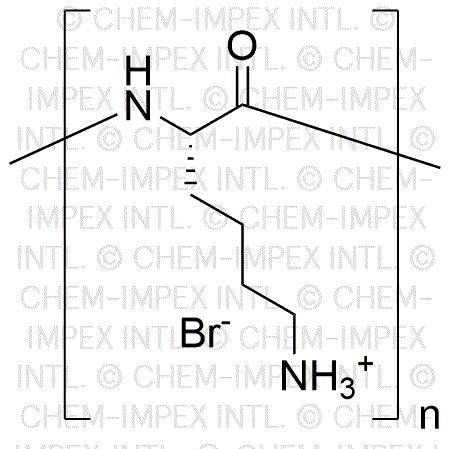Poly-L-lysine hydrobromide is widely utilized in research focused on:
- Biotechnology: It is commonly used as a cell culture substrate to enhance cell adhesion and growth, particularly for mammalian cells, improving the efficiency of bioproduction processes.
- Drug Delivery: This compound serves as a carrier for drug molecules, facilitating their transport across cell membranes, which is crucial in developing targeted therapies.
- Gene Therapy: It plays a significant role in gene delivery systems, helping to transport DNA or RNA into cells, thereby enhancing the effectiveness of gene therapy applications.
- Biomedical Research: Researchers utilize it in the development of biosensors and diagnostic tools, leveraging its properties to improve sensitivity and specificity in detecting biological markers.
- Cosmetics: The compound is incorporated into skincare products for its moisturizing properties, providing benefits such as improved skin hydration and barrier function.
General Information
Properties
Safety and Regulations
Applications
Poly-L-lysine hydrobromide is widely utilized in research focused on:
- Biotechnology: It is commonly used as a cell culture substrate to enhance cell adhesion and growth, particularly for mammalian cells, improving the efficiency of bioproduction processes.
- Drug Delivery: This compound serves as a carrier for drug molecules, facilitating their transport across cell membranes, which is crucial in developing targeted therapies.
- Gene Therapy: It plays a significant role in gene delivery systems, helping to transport DNA or RNA into cells, thereby enhancing the effectiveness of gene therapy applications.
- Biomedical Research: Researchers utilize it in the development of biosensors and diagnostic tools, leveraging its properties to improve sensitivity and specificity in detecting biological markers.
- Cosmetics: The compound is incorporated into skincare products for its moisturizing properties, providing benefits such as improved skin hydration and barrier function.
Documents
Safety Data Sheets (SDS)
The SDS provides comprehensive safety information on handling, storage, and disposal of the product.
Product Specification (PS)
The PS provides a comprehensive breakdown of the product’s properties, including chemical composition, physical state, purity, and storage requirements. It also details acceptable quality ranges and the product's intended applications.
Certificates of Analysis (COA)
Search for Certificates of Analysis (COA) by entering the products Lot Number. Lot and Batch Numbers can be found on a product’s label following the words ‘Lot’ or ‘Batch’.
*Catalog Number
*Lot Number
Certificates Of Origin (COO)
This COO confirms the country where the product was manufactured, and also details the materials and components used in it and whether it is derived from natural, synthetic, or other specific sources. This certificate may be required for customs, trade, and regulatory compliance.
*Catalog Number
*Lot Number
Safety Data Sheets (SDS)
The SDS provides comprehensive safety information on handling, storage, and disposal of the product.
DownloadProduct Specification (PS)
The PS provides a comprehensive breakdown of the product’s properties, including chemical composition, physical state, purity, and storage requirements. It also details acceptable quality ranges and the product's intended applications.
DownloadCertificates of Analysis (COA)
Search for Certificates of Analysis (COA) by entering the products Lot Number. Lot and Batch Numbers can be found on a product’s label following the words ‘Lot’ or ‘Batch’.
*Catalog Number
*Lot Number
Certificates Of Origin (COO)
This COO confirms the country where the product was manufactured, and also details the materials and components used in it and whether it is derived from natural, synthetic, or other specific sources. This certificate may be required for customs, trade, and regulatory compliance.


